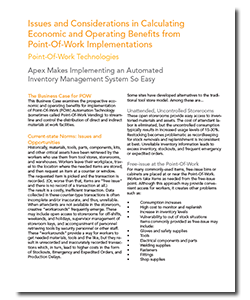Calculating Economic and Operating Benefits from Point-Of-Work Implementations
Enterprise-level deployments of Point-Of-Work Vending Systems will be essential for the success of companies.
The Business Case for POW
This Business Case examines the prospective economic and operating benefits for implementation of Point-Of-Work (POW) Automation Technology (sometimes called Point-Of-Work Vending) to streamline and control the distribution of direct and indirect materials at work facilities.
Current-state Norms: Issues and Opportunities
Historically, materials, tools, parts, components, kits, and other critical assets have been retrieved by the workers who use them from tool stores, storerooms, and warehouses. Workers leave their workplace, travel to the location where the needed items are stored, and then request an item at a counter or window.
The requested item is picked and the transaction is recorded. (Or, worse than that, items are “free issue” and there is no record of a transaction at all.)
The result is a costly, inefficient transaction. Data collected in these counter-type transactions is often incomplete and/or inaccurate, and thus, unreliable. When attendants are not available in the storeroom, creative “workarounds” frequently emerge.
These may include open access to storerooms for off-shifts, weekends, and holidays, supervisor management of storeroom keys, and accompaniment of personnel retrieving tools by security personnel or other staff.
These “workarounds” provide a way for workers to get needed materials, tools and the like, but they result in unrecorded and inaccurately recorded transactions which, in turn, lead to higher costs in the form of Stockouts, Emergency and Expedited Orders, and Production Delays. Some sites have developed alternatives to the traditional tool store model. Among these are...
Unattended, Uncontrolled Storerooms
These open storerooms provide easy access to inventoried materials and assets. The cost of attendant labor is eliminated, but the uncontrolled consumption typically results in increased usage levels of 15-30%. Restocking becomes problematic as recordkeeping for stock removals and replenishment is inconsistent at best. Unreliable inventory information leads to excess inventory, stockouts, and frequent emergency or expedited orders.
Free-issue at the Point-Of-Work
For many commonly-used items, free-issue bins or cabinets are placed at or near the Point-Of-Work. Workers take items as needed from the free-issue point.
Although this approach may provide convenient access for workers, it creates other problems such as:
- Consumption increases
- High cost to monitor and replenish
- Increase in inventory levels
- Vulnerability to out of stock situations
Items commonly provided as free-issue may include:
- Gloves and safety supplies
- Tools
- Electrical components and parts
- Welding supplies
- Fasteners
- Fittings
- Shop supplies
What’s Related
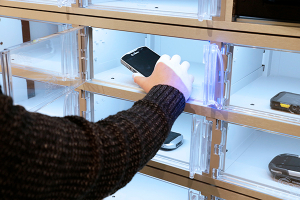
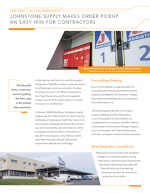
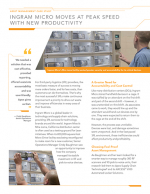
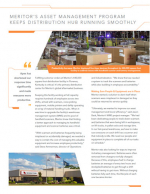
Favorites





